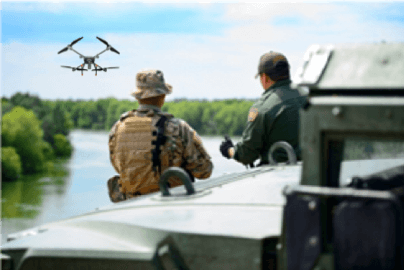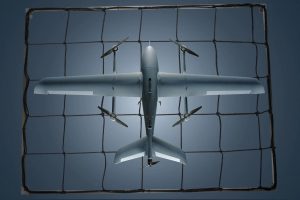Drones Revolutionizing Border Control and Security
Drones have dramatically reshaped border control and security worldwide, providing law enforcement with a powerful technological advantage. These modern border patrol drones enable quick surveillance, real-time threat detection, and improved response capabilities, enhancing border security and the safety of officers [1][3][4].
Why Drones Are Essential in Border Security
Imagine vast landscapes—mountains, forests, rivers, and deserts—spanning hundreds or thousands of kilometers. Traditionally, monitoring these expansive and hostile environments required a large workforce and costly manned aircraft. Now, with drones, border control feels less like pursuing a shadowy spy-movie adversary and more like operating a high-tech eye in the sky.
Key Advantages
- Swift Area Coverage: Drones can patrol and map extensive areas swiftly, providing officers a view far beyond their immediate surroundings [2][3][4].
- Real-Time Threat Detection: Equipped with onboard cameras, including night vision and thermal sensors, drones identify intruders, smugglers, or emergencies, streaming live video to command centers located miles away [1][3][5].
- Enhanced Agent Safety: Drones provide detailed situational intelligence—like the size of groups, their movements, and what suspects are carrying—improving safety and tactical planning for officers [4].
- Cost-Effective: Compared to helicopters or planes, drones significantly lower costs and can undertake repeat missions without fatigue [2][5].
Applications of Drones on Borders
When envisioning a border patrol agent, one might think of a Hollywood-like image of a lone ranger scanning the horizon with binoculars. The current reality is vastly different, featuring advanced unmanned aerial vehicles (UAVs) quietly operating in the sky.
1. Stopping Illegal Crossings
Drones can detect people attempting to cross borders unlawfully, even in complete darkness or challenging weather conditions. For example, thermal cameras can detect human heat signatures, and sophisticated AI software helps distinguish between a lost hiker and a trafficker [3][5].
2. Combating Smuggling and Drug Trafficking
Smugglers have long used tunnels, vehicles, and treks through remote areas. Now, border drones track moving vehicles and people, monitor suspicious activities, and guide ground teams with precision, aiding in the dismantling of organized criminal routes [1][5].
3. Human Trafficking Surveillance
Tragically, traffickers exploit border weaknesses for unlawful human movement. Drones provide constant surveillance over known crossing zones or “hot spots,” capturing activities that might indicate human trafficking [1][3][5].
4. Infrastructure and Fence Monitoring
Previously, damaged fences or barriers might go unnoticed for hours or even days. Now, drones rapidly inspect vast stretches of border, detect breaches or damages, and alert command centers promptly, accelerating repair processes and preventing potential exploitations [2].
5. Search and Rescue
In search and rescue missions—such as locating a missing migrant or a stranded traveler—drones swiftly cover extensive areas, using loudspeakers, infrared, or zoom to quickly find people and assist rescue teams [2][4].
6. Data Collection and Intelligence
Capable of recording high-definition imagery and analyzing on-the-ground activities, drones support investigative efforts, mapping emerging smuggling patterns and informing smarter border management policies and tactics [2][5].
Fun fact: In the U.S., some drones equipped with facial recognition and AI tools can identify persons of interest, directly linking border operations with intelligence and law enforcement systems [3].
Drone Technologies and Concepts in Border Security
For border security, not just any drone will suffice. Here’s a summary of the main drone types and their optimal uses on the border:
| Drone Type | Strengths and Usage |
|---|---|
| Fixed-point (Tethered) | Continuous overwatch at crossing points, operates for hours, permanent link [1][5]. |
| Free-flying Quadcopters | Agile, fast deployment, best for targeted patrol and incident response [2][3]. |
| Fixed-wing UAVs | Cover vast open areas, often used for miles-long patrols [5]. |
| Drone-in-a-Box Systems | Autonomous takeoff/landing from dock stations, ideal for instant missions [2]. |
More sophisticated systems offer 30x optical zoom, automatic battery swap (within 2 minutes!), and can operate in extreme temperatures ranging from -25°C to +60°C [2].
Real-World Examples: Innovation and International Cooperation
- Nestor Project (EU): By integrating drones and AI, this initiative aims to create harmonized border surveillance across several European nations, enhancing both operational efficiency and safeguarding human rights [1].
- US-Canada Niagara Exercise: This joint simulation employs drones to track and intercept contraband-smuggling UAVs across the river border, emphasizing the importance of cross-border communication and cooperation [6].
- US Border Patrol (CBP): Agents now utilize small drones for immediate “eyes in the sky,” providing quick and cost-effective air support [4][8].
Tackling Rogue Drones: Implementing Counter-Drone Solutions
As law enforcement increasingly relies on drones, so do criminals. Drones have been used to smuggle drugs, weapons, and even people [6][7]. Hence, counter-drone technologies (C-UAS), like advanced radio detection, jamming, and drone interceptors, are becoming essential to thwart unauthorized UAVs on both sides of the border [6][7].
Integration with Other Security Technologies
Modern drone patrols don’t operate in isolation. They are integrated with ground sensors, AI-powered analytics, vehicle patrols, and fixed cameras, forming a multi-layered “smart barrier” where each system complements the others, providing more reliable and timely threat detection [2][4][5].
Training, Compliance, and Optimization
Operating drones in sensitive border regions necessitates:
- Specialized training: focusing on flying, analytics, and emergency response techniques [2][5].
- Strict adherence to laws: including privacy, airspace regulations, and use-of-force protocols [3][5].
- Continual system monitoring and optimization: to ensure peak performance and operational safety [2].
Strategies and Recommendations for Border Agencies
- Select drones: suited to your specific climate and terrain—the same drone that works in Arizona likely won’t be suitable for use in northern Norway [2].
- Ensure seamless system integration: with existing software and command centers for optimal efficiency [2][5].
- Develop long-term maintenance and data management strategies: given the significant amount of footage collected by drones [2].
- Focus on community relations: to ensure that surveillance activities do not infringe on individual rights or trust [2].
Human Element Behind Technology
Behind every drone mission is a team of skilled professionals—technicians, pilots, data analysts, and border agents—collaborating effectively. Many have remarkable stories, like a U.S. agent recalling a drone-assisted effort to find a lost child in the desert, or engineers in Europe leveraging drones to dismantle a cross-border smuggling operation. These personal successes showcase the profound impact of drone technology. Some agencies even conduct “drone ride-alongs,” allowing local officials or journalists firsthand drone mission experiences, fostering transparency and shared mission objectives.
Future Directions and Trends
- Artificial Intelligence: Drones are becoming increasingly autonomous, capable of detecting, tracking, and even predicting suspicious behaviors with minimal human oversight [3][5].
- Hybrid-Powered Drones: Equipped for long-duration flights with rapid deployment features for extended missions.
- Interconnected Sensor Networks: Drones function as vital components of broader “smart” border management systems [2][5].
- International Collaboration Protocols: More governments are setting joint drone operations rules, facilitating swift cross-border pursuits and mutual defense efforts [6].
An expert humorously notes: “In the next decade, a border patrol agent’s most crucial tool might not be boots and binoculars, but an app controlling a fleet of drones.”
Beyond the Technology: Myths and Pop Culture
From thrilling Netflix series to humorous memes about drone pilots “playing video games at work,” drones are featured widely in popular culture. While most border drones lack the glamour seen in “Sicario: Day of the Soldado,” they quietly ensure global safety day and night.
Engaging with Drone Security Solutions
Our team is dedicated to advancing smarter and safer border management—not only through technology but by valuing input, innovation, and care. We remain at the pinnacle of drone technology, eager to help evaluate your individual needs, select the appropriate equipment, and implement effective solutions—from system integration and comprehensive training to continuous support.
Interested in discussing your challenges or witnessing a demonstration? Our experts are ready to assist—let’s work together to shape the future of border security.
Inspired by genuine stories, driven by cutting-edge technology, and delivered by people who believe that the safest borders are where humanity and innovation converge.













